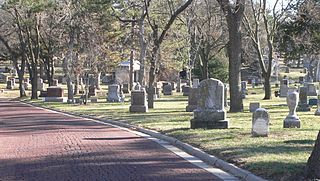
The Christian Church (Disciples of Christ) is a mainline Protestant Christian denomination in the United States and Canada. The denomination started with the Restoration Movement during the Second Great Awakening, first existing during the 19th century as a loose association of churches working towards Christian unity, then slowly forming quasi-denominational structures through missionary societies, regional associations, and an international convention. In 1968, the Disciples of Christ officially adopted a denominational structure at which time a group of churches left to remain nondenominational.

Lincoln is the capital of the U.S. state of Nebraska and the county seat of Lancaster County. The city covers 100.4 square miles (260.035 km2) and had a population of 294,757 in 2023. It is the state's second-most populous city and the 71st-largest in the United States. Lincoln is considered the economic and cultural anchor of the substantially larger metropolitan area in southeastern Nebraska, the Lincoln Metropolitan and Lincoln-Beatrice Combined Statistical Areas, which is home to 361,921 people, the 104th-largest combined statistical area in the United States.

The Restoration Movement is a Christian movement that began on the United States frontier during the Second Great Awakening (1790–1840) of the early 19th century. The pioneers of this movement were seeking to reform the church from within and sought "the unification of all Christians in a single body patterned after the church of the New Testament."
The group of churches known as the Christian Churches and Churches of Christ is a fellowship of congregations within the Restoration Movement that have no formal denominational affiliation with other congregations, but still share many characteristics of belief and worship. Churches in this tradition are strongly congregationalist and have no formal denominational ties, and thus there is no proper name that is agreed upon and applied to the movement as a whole. Most congregations in this tradition include the words "Christian Church" or "Church of Christ" in their congregational name. Due to the lack of formal organization between congregations, there is a lack of official statistical data, but the 2016 Directory of the Ministry documents some 5000 congregations in the US and Canada; some estimate the number to be over 6,000 since this directory is unofficial. By 1988, the movement had 1,071,616 members in the United States.

Bethany College is a private liberal arts college in Bethany, West Virginia. Founded in 1840 by Alexander Campbell of the Restoration Movement, who gained support by the Virginia legislature, Bethany College was the first institution of higher education in what is now West Virginia.
Nebraska Public Media, formerly Nebraska Educational Telecommunications (NET), is a state network of public radio and television stations in the U.S. state of Nebraska. It is operated by the Nebraska Educational Telecommunications Commission (NETC). The television stations are all members of the Public Broadcasting Service (PBS), while the radio stations are members of National Public Radio (NPR).

Bethany is a neighborhood and former town in the northeast region of the city of Lincoln, Nebraska, United States.
Benjamin Franklin was an important conservative figure in the American Restoration Movement, especially as the leading antebellum conservative in the northern United States branch of the movement. He is notable as the early and lifelong mentor of Daniel Sommer, whose support of the 1889 Sand Creek Declaration set in motion events which led to the formal division of the Churches of Christ from the Disciples of Christ in 1906.
The Hixson–Lied College of Fine and Performing Arts is the fine and performing arts college at the University of Nebraska–Lincoln (NU) in Lincoln, Nebraska. The college was established on July 1, 1993 as the College of Fine and Performing Arts, combining arts-focused programs from across the university. It was renamed in 2000 after receiving an $18 million donation from Christina Hixson and Lied Foundation Trust. Most of the college's facilities are located in the southwest corner of NU's City Campus in what is sometimes referred to as the "Arts Quadrangle." Andy Belser has served as dean of the college since 2022.

The International Quilt Museum at the University of Nebraska–Lincoln in Lincoln, Nebraska is the home of the largest known public collection of quilts in the world. Formerly known as the International Quilt Study Center and Museum, the current facility opened in 2008.
Lincoln City Libraries is the official public library system in Lincoln, Nebraska, United States. It has eight branches.

Wyuka Cemetery is the largest cemetery in Lincoln, Nebraska.
The Nebraska Innovation Campus is a public/private research campus being developed by the University of Nebraska–Lincoln. It is located in Lincoln, Nebraska on the 249-acre (1.01 km2) site of the old Nebraska State Fair grounds.

Nebraska Field was an American football stadium located on the campus of the University of Nebraska in Lincoln, Nebraska. The stadium primarily served as the home venue for the Nebraska Cornhuskers football team and a variety of other university and state activities. Nebraska Field was demolished in 1923 when the university constructed Memorial Stadium on its former site.

Lincoln, Nebraska has many neighborhoods, including 45 recognized by Urban Development, City of Lincoln. A list and description of neighborhoods within Lincoln city limits follows.

College View is a neighborhood in southeast Lincoln, Nebraska, United States which was previously a village in Lancaster County.
The following is a timeline of Lincoln, Nebraska history including significant social, political, cultural, and economic events in the history of Lincoln.
Margueritte Harmon Bro was an American minister, missionary in China, and author of books. Her article about the American seer Edgar Cayce, "Miracle Man of Virginia Beach," published in the magazine Coronet in 1943, resulted in a deluge of inquiries to the magazine and to Cayce. Bro's books were reviewed by scholarly journals and one of her books was recommended to be used in elementary schools by the Arkansas Department of Education.

The James A. Beattie House, also known as the Beattie Miles House, is a Queen Anne style home built in the Bethany Heights neighborhood of Lincoln, Nebraska, in 1892. The James A. Beattie House is listed on the National Register of Historic Places for its architecture as well as its historical connection with the settlement of the region.














